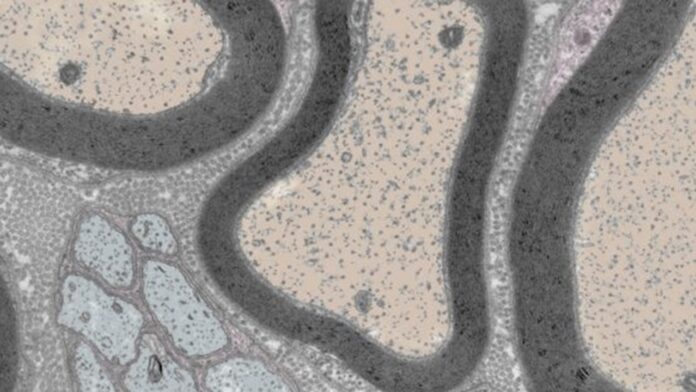Every year in the U.S., over 3 million people experience peripheral neuropathy, where nerves outside the brain and spinal cord are damaged, causing pain and loss of feeling.
Salk researchers at Salk Institute found a way to repair damaged nerves in mice during peripheral neuropathy. They identified a protein called Mitf that activates the repair function of special nerve cells. These findings, published in Cell Reports on November 28, 2023, could lead to new treatments for healing peripheral neuropathy.
Senior author Professor Samuel Pfaff said, “We wanted to know what mechanisms control damage response in peripheral nerves under conditions like acute trauma, genetic disorders, or degenerative diseases. We found that Schwann cells, special cells in nerves that protect and support neurons’ axons, enter their repair state because of a pathway mediated by the protein Mitf.”
The peripheral nervous system includes all the nerves spreading from the brain and spinal cord, providing sensation throughout our bodies. Pfaff and team study neurons, transmitting information, and Schwann cells, protecting and repairing nerves. Unlike the central nervous system (brain and spinal cord), which can’t repair damage, the peripheral system’s repair ability is remarkable. However, the mechanisms behind this feat still need to be better understood.
Researchers studied mouse models of Charcot Marie Tooth disease (CMT) to understand how Schwann cells differentiate and initiate repair in peripheral nerve damage.
First author Lydia Daboussi, a former postdoctoral researcher in Pfaff’s lab and current assistant professor at UC Los Angeles, said, “Going into this project, I thought that when you have a genetic nerve degeneration disorder, cells are dying and recovery isn’t possible. However, our findings show that there are gene programs turned on by Mitf that repair some of the damage in those chronic disease scenarios. When you turn those programs off, disease symptoms get worse.”
In mice with CMT, the researchers discovered that Schwann cells involved in repairs had high levels of Mitf in their nuclei, where instructions for being a Schwann cell and conducting repairs are stored. They found that Mitf stays in the cell’s cytoplasm until it senses nerve damage.
Mitf moves from the cytoplasm to the nucleus when damage occurs, instructing the Schwann cell to make repairs. To confirm Mitf’s role in creating repair Schwann cells, the researchers removed Mitf. In trauma and CMT cases, nerve repair was halted without Mitf, proving its essential role in peripheral nerve repair and regeneration.
In mice with CMT, the researchers discovered that Schwann cells involved in repairs had high levels of Mitf in their nuclei, where instructions for being a Schwann cell and conducting repairs are stored. They found that Mitf stays in the cell’s cytoplasm until it senses nerve damage.
Mitf moves from the cytoplasm to the nucleus when damage occurs, instructing the Schwann cell to make repairs. To confirm Mitf’s role in creating repair Schwann cells, the researchers removed Mitf. In trauma and CMT cases, nerve repair was halted without Mitf, proving its essential role in peripheral nerve repair and regeneration.
Pfaff, also the Benjamin H. Lewis Chair at Salk, said, “Harnessing Schwann cell repair programs has great potential in treating chronic diseases. “It’s possible that with targeted therapeutics, we can prompt more Schwann cells to repair peripheral nerve damage and push those repairs to completion in chronic cases. Furthermore, now that we better grasp the repair mechanisms, we can see if initiating repairs in the brain stem and spinal cord is possible, too.”
In mice with CMT, the researchers discovered that Schwann cells involved in repairs had high levels of Mitf in their nuclei, where instructions for being a Schwann cell and conducting repairs are stored. They found that Mitf stays in the cell’s cytoplasm until it senses nerve damage.
Mitf moves from the cytoplasm to the nucleus when damage occurs, instructing the Schwann cell to make repairs. To confirm Mitf’s role in creating repair Schwann cells, the researchers removed Mitf. In trauma and CMT cases, nerve repair was halted without Mitf, proving its essential role in peripheral nerve repair and regeneration.
This study from Salk Institute sheds light on the intricate mechanisms involved in repairing nerve cells after injury and in chronic diseases. By identifying the crucial role of Mitf in activating Schwann cells’ repair functions, the research paves the way for potential therapeutic strategies to enhance peripheral nerve repair and regeneration.
Journal reference:
- Lydia Daboussi, Giancarlo Costaguta, et al., and Mitf are Schwann cell sensors of axonal integrity that drive nerve repair. Mitf is a Schwann cell sensor of axonal integrity that goes nerve repair. Cell Reports. DOI: 10.1016/j.celrep.2023.113282.
